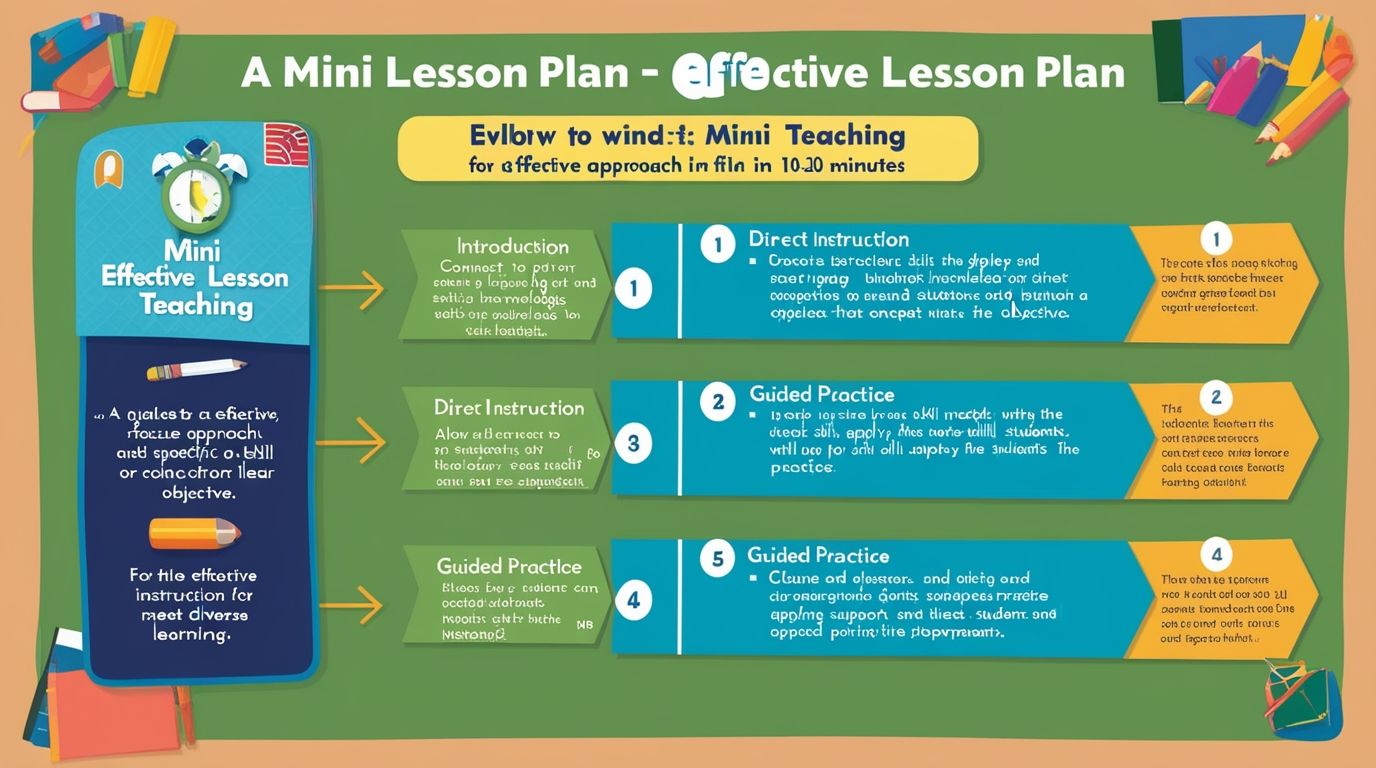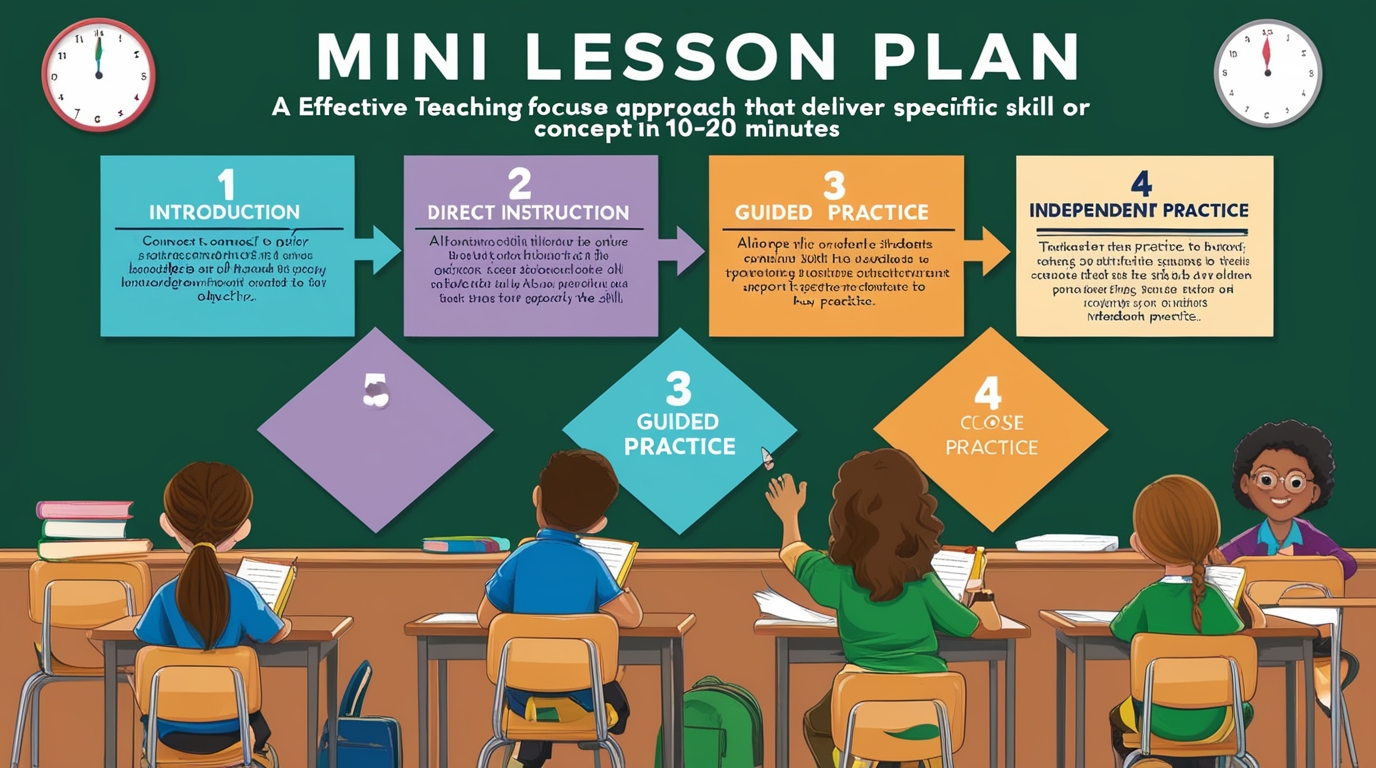Mini Lesson Plan for Effective Teaching, A mini lesson plan is a concise, targeted teaching approach designed to focus on a specific skill or concept in a short period of time, typically 10 to 20 minutes. This strategy is especially effective in modern classrooms, where time is limited, and differentiated instruction is necessary to meet the diverse learning needs of students. The key to creating an effective mini lesson plan lies in its simplicity and clarity, ensuring that students can grasp the objective within the allotted time. This article outlines how to design a mini lesson plan for effective teaching, breaking down the process into essential steps, and demonstrating the benefits of using mini lessons in various educational contexts.
The Structure of a Mini Lesson Plan
The mini lesson is generally composed of four distinct stages:
- Introduction (Connection)
- Direct Instruction (Explicit Teaching)
- Guided Practice
- Closure and Independent Practice
This structure ensures that the lesson remains focused, engaging, and accessible to all students.
1. Introduction (Connection)
The introduction is where the teacher establishes the relevance of the lesson by connecting it to prior knowledge or real-world contexts. During this phase, the teacher introduces the learning objective and explains why it is important. This helps students understand the purpose of the lesson and how it fits into their broader learning journey.
For example, in a mini lesson about identifying main ideas in reading, the teacher might begin by asking students about a time they had to summarize a movie plot. This connection to everyday experiences engages students and allows them to see the relevance of the skill they are about to learn.
Key strategies in this phase include:
- Asking open-ended questions to activate prior knowledge.
- Briefly outlining what will be covered in the lesson.
- Relating the lesson content to students’ personal experiences or future learning.

2. Direct Instruction (Explicit Teaching)
In this phase, the teacher directly teaches the skill or concept using clear and concise explanations. The goal is to present the information in a way that is easy for students to understand within the short time frame of a mini lesson. This step requires the teacher to be concise, yet thorough, ensuring that students grasp the concept without overwhelming them with too much information.
One effective method for this phase is the “I Do, We Do, You Do” model:
- I Do: The teacher demonstrates or models the skill.
- We Do: The teacher and students practice the skill together.
- You Do: Students practice the skill independently under teacher supervision.
For example, if the lesson focuses on multiplication, the teacher might first model how to multiply two numbers (I Do). Then, the teacher and the students work through a problem together (We Do). Finally, students attempt to solve a multiplication problem on their own while the teacher monitors their progress (You Do).
Key strategies for direct instruction include:
- Modeling the desired skill or behavior.
- Using visuals or manipulatives to enhance understanding.
- Keeping explanations clear and to the point.
- Checking for understanding through quick assessments, such as asking questions or using response cards.
3. Guided Practice
Guided practice allows students to apply what they have learned with the teacher’s support. This stage is crucial for reinforcing the lesson’s content and giving students the opportunity to ask questions or clarify misunderstandings before they move on to independent practice. The teacher circulates around the room, providing feedback and offering assistance as needed.
During guided practice, the teacher may use small group activities, partner work, or individual tasks. For instance, in a writing mini lesson about crafting a topic sentence, the teacher might ask students to draft topic sentences for a given prompt while offering immediate feedback. The purpose of this phase is to build student confidence and ensure they are ready for independent work.
Key strategies for guided practice include:
- Offering feedback and encouragement.
- Providing scaffolding for students who may struggle.
- Engaging students in collaborative activities to reinforce learning.
4. Closure and Independent Practice
In the final phase, the teacher concludes the lesson by summarizing the key points and checking for student understanding. This brief closure reinforces the main takeaways of the lesson, ensuring that students have a clear understanding of the skill or concept. The teacher may ask students to reflect on what they learned, or invite them to share their thoughts in pairs or with the class.
Independent practice, which follows the closure, allows students to apply the skill or concept independently, often as homework or during a designated work period. This practice is crucial for mastery, as it gives students the opportunity to internalize and apply what they have learned without immediate teacher assistance.
For example, after a mini lesson on using descriptive language in writing, students might be asked to write a short paragraph at home that incorporates the techniques discussed in class. The teacher can review these assignments to assess student understanding and inform future lessons.
Key strategies for closure and independent practice include:
- Summarizing the lesson’s main points.
- Asking students to articulate what they have learned.
- Assigning independent work that aligns with the lesson’s objectives.

Benefits of Mini Lessons
Mini lessons provide several key benefits that make them an effective teaching tool.
1. Focused Learning
Mini lessons are designed to focus on a single skill or concept, allowing students to concentrate their attention without being overwhelmed by too much information. This targeted approach helps students understand the material more thoroughly and apply it in future contexts. Teachers can scaffold lessons by breaking down complex topics into smaller, manageable segments.
2. Engagement and Active Participation
Because mini lessons are brief and interactive, they are highly engaging for students. The structure of a mini lesson ensures that students remain actively involved in the learning process, whether through answering questions, participating in discussions, or practicing a skill. This level of engagement is crucial for retention and comprehension.
3. Differentiation
Mini lessons are ideal for differentiating instruction, as they allow teachers to tailor content to meet the diverse needs of their students. For example, a teacher might provide one mini lesson to the whole class and then break students into small groups for more targeted instruction based on their skill levels. This flexibility ensures that all students are challenged and supported appropriately.
4. Efficient Use of Time
In a busy classroom, time is often a limiting factor. Mini lessons allow teachers to make the most of their instructional time by focusing on key skills and concepts in a short period. This efficiency ensures that lessons are productive and that students have ample time for practice and reflection.
Conclusion
An effective mini lesson plan is a powerful tool for enhancing teaching and learning. By focusing on one skill or concept at a time, using clear and concise direct instruction, and providing opportunities for guided and independent practice, teachers can ensure that students master the material in a short period of time. Mini lessons promote engagement, allow for differentiation, and make efficient use of classroom time. As a result, they are an excellent strategy for addressing the diverse learning needs of today’s students and ensuring that instructional time is used effectively.
References
- Fountas, I. C., & Pinnell, G. S. (2017). Guided Reading: Responsive Teaching Across the Grades. Heinemann.
- Tomlinson, C. A. (2017). How to Differentiate Instruction in Academically Diverse Classrooms. ASCD.
- Marzano, R. J. (2007). The Art and Science of Teaching: A Comprehensive Framework for Effective Instruction. ASCD.
- Hattie, J. (2012). Visible Learning for Teachers: Maximizing Impact on Learning. Routledge.

7 thoughts on “Mini Lesson Plan for Effective Teaching”
Comments are closed.